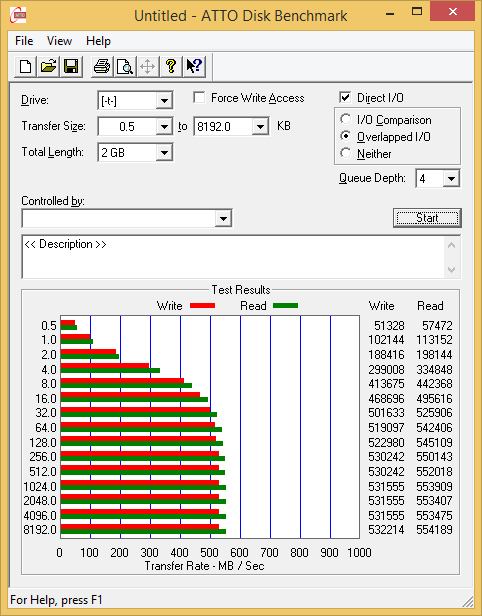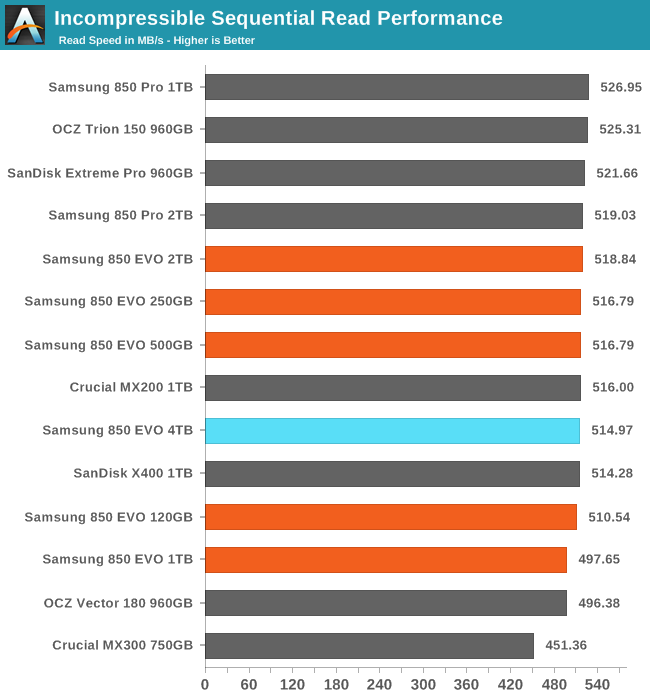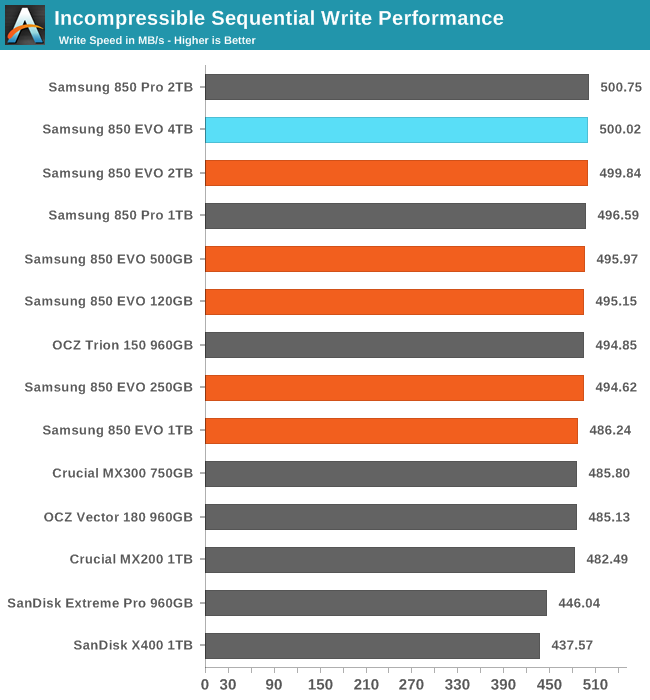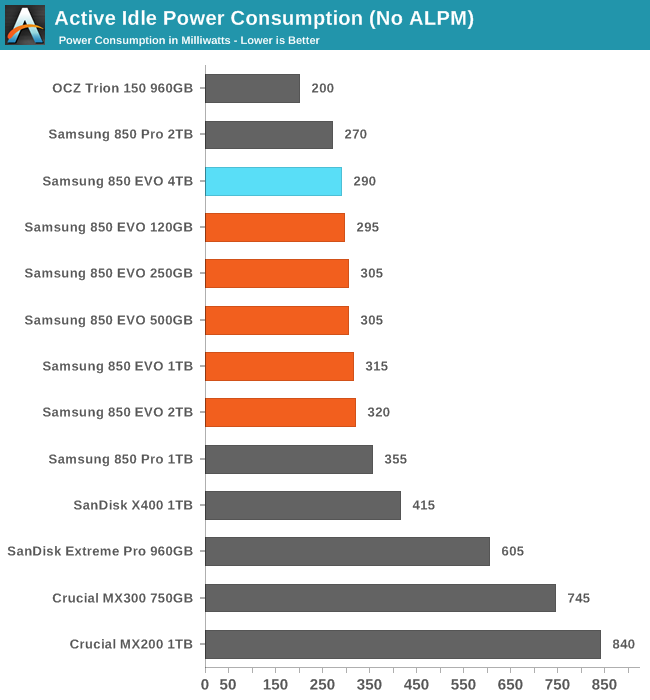The Samsung 850 EVO 4TB SSD Review
by Billy Tallis on July 11, 2016 10:00 AM ESTATTO
ATTO's Disk Benchmark is a quick and easy freeware tool to measure drive performance across various transfer sizes.
 |
|||||||||
The ATTO plot for the 4TB 850 EVO shows no problems and very slightly better read speeds than the 2TB 850 EVO.
AS-SSD
AS-SSD is another quick and free benchmark tool. It uses incompressible data for all of its tests, making it an easy way to keep an eye on which drives are relying on transparent data compression. The short duration of the test makes it a decent indicator of peak drive performance.


As expected, the AS-SSD results are unremarkable. Even if the new V-NAND were slower, the 4TB drive has more than enough parallelism to provide peak performance that saturates the SATA link.
Idle Power Consumption
Since the ATSB tests based on real-world usage cut idle times short to 25ms, their power consumption scores paint an inaccurate picture of the relative suitability of drives for mobile use. During real-world client use, a solid state drive will spend far more time idle than actively processing commands. Our testbed doesn't support the deepest DevSlp power saving mode that SATA drives can implement, but we can measure the power usage in the intermediate slumber state where both the host and device ends of the SATA link enter a low-power state and the drive is free to engage its internal power savings measures.
We also report the drive's idle power consumption while the SATA link is active and not in any power saving state. Drives are required to be able to wake from the slumber state in under 10 milliseconds, but that still leaves plenty of room for them to add latency to a burst of I/O. Because of this, many desktops default to either not using SATA Aggressive Link Power Management (ALPM) at all or to only enable it partially without making use of the device-initiated power management (DIPM) capability. Additionally, SATA Hot-Swap is incompatible with the use of DIPM, so our SSD testbed usually has DIPM turned off during performance testing.


The 4TB EVO has slightly lower idle power consumption than the 2TB EVO, but both still draw twice as much power in the slumber state as the smaller 850 EVOs with the MEX and MGX controllers.










145 Comments
View All Comments
jardows2 - Monday, July 11, 2016 - link
What is the use case for this drive? $1500 for mass storage? Price per GB may be comparable to smaller drives, but that is still a huge chunk of change to get, what?It's a consumer drive, not an Enterprise drive. Video and Photo editors are going to hit it hard, so the lower endurance rating is going to hurt it for use in those applications. All I can see is that it is a halo product to push the industry forward, purchased only by those who have lots of spare cash to spend. Am I missing something?
ddriver - Monday, July 11, 2016 - link
RAW photos, audio, video, basically any kind of data acquisition - those eat a lot of capacity. At 1500$ I'd argue this is not a consumer but a prosumer product.vladx - Monday, July 11, 2016 - link
This type of product is for people rich enough to not care about the price. Simple as that.MScrip - Monday, July 11, 2016 - link
I'd say video editing. It's not uncommon to come home with a terabyte of footage from multiple 4K cameras over multiple days of shooting. And you may be editing multiple projects at a time.This would make a hell of a media drive... fast and local.
And when you're done with the projects... you move them to slower mass storage for safekeeping.
jardows2 - Monday, July 11, 2016 - link
My point being, if you are a hobbyist, $1500 is a huge entry point, especially when the, albeit slow, hard drives come in a just a couple hundred dollars.If you are a professional, you are going to want Enterprise level drives with the endurance and warranty support. But if you are using multiple cameras shooting 4K footage, you probably have so much invested there, that $1500 for a storage drive isn't a huge percentage of the overall equipment budget. For me, I'm just using a 1080p camcorder for now, so my budget is way lower!
MScrip - Monday, July 11, 2016 - link
I'm mostly 1080p... with occasional 4K. I don't need this 4TB drive... but I've got my eye on the 1TB version. Right now I'm editing on a 1TB WD Black... and its slowness shows!Is $1500 expensive? It depends. It's just a bigger version of the 2TB model... which is a bigger version of the 1TB model... etc.
Drives in higher capacities always cost more money... especially the first of its kind (4TB in a single SSD)
Asking "who is this for?" is usually a difficult question. My best guess... I'd say it's for someone who wants a single SSD... but needs to hold more than 2TB. :)
Impulses - Monday, July 11, 2016 - link
Moved to 2x 1TB 850 EVOs myself a while back (with an SM951 256GB for OS/apps), can't wait until the higher capacities come down in price... Depending on how much of a premium the 4TB sustains over time I could see myself adding one (or two) 2TB or just going straight to 4TB.Mostly working with 1080p and relatively small 16MP RAWs... Bought the 1TB before the 2TB was readily available but I don't really regret that bit, higher seqs when going to the SM951 and easier to repurpose them later on.
Silh - Monday, July 11, 2016 - link
One use case, which is admittedly niche: musicians using virtual instruments.Instrument sample libraries can run into the multi-gigabyte range (have ~2gb in total myself, and I'm only a hobbyist), and are built up of recordings of instruments playing single notes in various volumes, styles, etc., depending on the library's level of detail sometimes recordings of the transitions between notes.
Less detailed virtual instruments may only eat up a few hundred MB in samples; it's not a huge deal to load the entire thing into memory for those. However, more detailed ones can run in the tens of GB's per instrument for all the different layers, and once you start building up an entire virtual orchestra, you will have to resort to loading them from the disk during playback, and for that you require something with low latency and high throughput... hence the use of SSD's. Don't even need the write endurance in a case like this, even.
ddriver - Monday, July 11, 2016 - link
Nah, you really want samples loaded in RAM. RAM is cheap, even a modest DAW system will have at least 16 gigs of ram. Latency really matters here, and RAM latency is much, much lower than SSD, and sample libraries aren't that big. Sure, there are a few libraries in excess of 30 GB, but you really use a much smaller subset of the whole thing at a time.Silh - Monday, July 11, 2016 - link
It really depends on which sample libraries you're using, and some of the big ones get quite huge. The (perhaps now mere) 32gb RAM on my system only can hold so much, especially with some of the big EastWest libraries.The other advantage of course, is that I can load my entire template in a matter of a couple of minutes instead of waiting 15 minutes for it to load off a regular HDD.